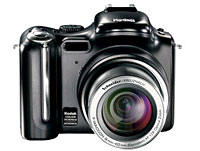 With a flurry of clicking and whirring, Kodak have announced their new Easyshare P712 superzoom digital camera, offering a 12x image-stabilised Lens, a 7.1 MP sensor and enough manual modes to please compulsively tinkersome photographers.
With a flurry of clicking and whirring, Kodak have announced their new Easyshare P712 superzoom digital camera, offering a 12x image-stabilised Lens, a 7.1 MP sensor and enough manual modes to please compulsively tinkersome photographers.
The camera sports a veritable animal of a zoom, with the f2.8 – f/3.7, Schneider-Kreuznach Variogon lens covering a whopping 36 – 432 mm range (35mm equivalent).
With such a long lens, things are likely to get wobbly at the telephone end, so there’s built in optical image stabilisation to help ward off blurificartion.
Faster than the blink of an eye
The boys and girls at Kodak are making bold claims for their new camera, saying that P712’s auto-focus system boasts a ‘best-in-class’ click-to-capture rate – literally faster than the blink of an eye, they say.
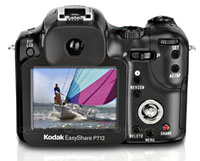 We’ve never bothered to work out how fast we blink, but Kodak tell us that their 0.07 seconds capture rate is faster, and who are we to argue?
We’ve never bothered to work out how fast we blink, but Kodak tell us that their 0.07 seconds capture rate is faster, and who are we to argue?
Made for sharing
The Easyshare comes with a large 2.5-inch, high-resolution, LCD and electronic viewfinder for framing and reviewing pictures, with the Share button making it easy to, err, share pics using Kodak’s, err, Easyshare software which, like Quality Street, was apparently made for sharing.
As is de rigueur with consumer digicams, the camera can record video at a TV-quality, 30 frames-per-second VGA video with sound (MPEG4), with onboard facilities to split, cut, merge and trim footage or create single-frame or multi-frame “storyboard” still pictures.
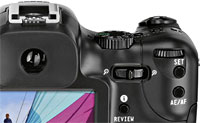 Flashing it about
Flashing it about
As well as the built in flash (guide no. 11, ISO 100 ), there’s a also a hot shoe connector for attaching the optional Kodak P20 zoom flash (which knocks out for around a ton).
Rounding off the feature set is the usual legion of scene, program, aperture/shutter priority and manual shooting modes, a hefty wad of preset scene modes and multiple burst modes for action shooting.
There’s also a live histogram display; 25 selectable AF points; custom white balance with selectable compensation; highlight/shadow clipping displays; and, in line with its semi-pro aspirations, RAW file support.
The P712 camera should be shuffling onto UK shelves around about now, with a suggested retail price of £350 – which, puts it in direct competition with the highly rated and far more versatile Nikon D50 dSLR, which starred in our ‘Best of 2005’ list.
 Kodak EasyShare P712 specifications
Kodak EasyShare P712 specifications
Sensor 1/2.5 ” Type CCD, 7.1 million effective pixels
Image sizes 3072 x 2304, 3072 x 2048 (3:2), 2592 x 1944, 2048 x 1536, 1280 x 960
Movie clips 640 x 480 @ 30fps, 320 x 240 @ 30fps, QuickTime video, motion JPEG
File formats JPEG (Exif v 2.21), RAW, TIFF
Lens 36 – 432mm equiv, Schneider-Kreuznach Variogon lens, 12x optical zoom
Image stabilization Yes
Conversion lenses Optional
Digital zoom 5x advanced
Focus Hybrid AF system using TTL contrast detection method and external passive sensor
Focus modes Normal AF, Macro AF, Infinity AF, Manual focus, Multi-zone, Center zone, Selectable zone (25 zones selectable)
AF assist lamp Yes
Focus distance Normal: 50cm – infinity (wide) 1.9m – infinity (tele)
Macro: 10-60cm (wide) 90cm – 2m (tele)
Metering Multi-pattern, Center-weighted, Center spot, Selectable zone (25 zones)
ISO sensitivity Auto, ISO 64/80/100/125/160/200/250/320/400/800
Exposure compensation +/- 2.0 EV, 1/3 EV steps
Exposure bracketing +/- 2.0 EV, 1/3, 2/3, 1.0 EV steps, 3 or 5 images
Shuttter speed 16 – 1/1000 sec in 1/3 step increments
Aperture F2.8 – 3.7
Modes Auto, SCN (scene mode), P (program mode), A (aperture priority mode), S (shutter priority mode), M (manual mode), C (custom mode), video
Scene modes Pportrait, self-portrait, sport, party, landscape, night portrait, night landscape, snow, beach, text/document, flower, sunset, candlelight, backlight, manner/museum, fireworks, panorama White balance Auto, daylight, cloudy, open shade, sunset, tungsten, fluorescent, click WB, custom
White balance fine tune Blue/red bias and magenta/green bias, ±7 stops
Self timer 2 / 10 secs, 2 shot option
Continuous shooting First burst (approx. 1.6 fps up to 14 frames at standard JPEG), Last burst (approx. 1.6 fps last 5 frames at standard JPEG)
Image parameters High colour, natural colour, low colour, sepia, black and white, Contrast (3 levels), Sharpness (3 levels)
Flash Guide no. 11 (ISO 100)
Range: wide – 0.9-4.7 m (2.9′-15.4′), tele – 2.0-3.6 m (6.6′-11.8′)
Modes: auto, fill, red-eye, slow sync (front, front-red-eye, rear), off
Compensation: ±1.0 EV with 1/3 EV steps
Viewfinder Electronic, 237 K pixels with diopter adjustment
LCD monitor 6.35 cm (2.5″) indoor/outdoor colour TFT display with adjustable brightness setting
Connectivity A/V output (NTSC or PAL, user-selectable)
Storage SD/MMC card (none supplied), 32MB internal memory
Weight (no batt) 403g
Dimensions 108 x 84.2 x 72 mm (4.3″ x 3.3″ x 2.8″)
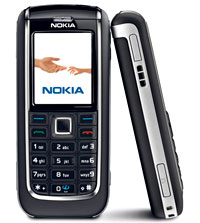 Slipping and slithering down the well oiled product slipway at Nokia is their latest swishy tri-band phone, the Nokia 6080 (no relation to their 1997 phone of the same name!).
Slipping and slithering down the well oiled product slipway at Nokia is their latest swishy tri-band phone, the Nokia 6080 (no relation to their 1997 phone of the same name!).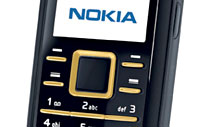 Sporting a backlit keypad and bright colour display, the handset comes bundled with a stereo headset and offers all the usual customisation options (with wallpapers, themes, annoying ring tones etc) to keep da kidz happy.
Sporting a backlit keypad and bright colour display, the handset comes bundled with a stereo headset and offers all the usual customisation options (with wallpapers, themes, annoying ring tones etc) to keep da kidz happy.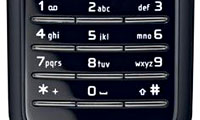 Talk time is a distinctively average 3.5 hours with a standby time of up to 12 days.
Talk time is a distinctively average 3.5 hours with a standby time of up to 12 days. New from Onkyo is the CR-D1, a natty mini Hi-Fi CD/FM receiver with options to control docked iPods (volume/stop/start etc) and wirelessly stream music from PCs.
New from Onkyo is the CR-D1, a natty mini Hi-Fi CD/FM receiver with options to control docked iPods (volume/stop/start etc) and wirelessly stream music from PCs. When it comes to expansion options, this fella’s well stacked, offering 1 x optical, 3 x RCA, and stereo mini-jack inputs and 1 x optical, 2 x RCA, subwoofer, and headphone outputs.
When it comes to expansion options, this fella’s well stacked, offering 1 x optical, 3 x RCA, and stereo mini-jack inputs and 1 x optical, 2 x RCA, subwoofer, and headphone outputs.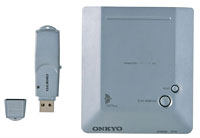 Specifications
Specifications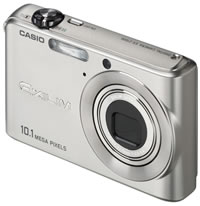 Just how much resolution do you need? Ten million pixels is a lot of information by any conventional measure, especially since most consumers rarely print out images larger than traditional 10x15cm enprints. That requires no more than the three megapixel sensors found on today’s very cheapest cameras, and now even high-end cameraphones.
Just how much resolution do you need? Ten million pixels is a lot of information by any conventional measure, especially since most consumers rarely print out images larger than traditional 10x15cm enprints. That requires no more than the three megapixel sensors found on today’s very cheapest cameras, and now even high-end cameraphones.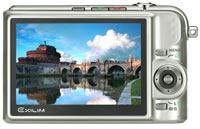 Around the back, a bright 2.8-inch widescreen LCD monopolises the available space. Only 2.5-inches is available for framing – the remainder is taken up by a fantastic vertical menu strip for instantly tweaking image size, quality, metering and more. Creative features are eclectic rather than comprehensive: a continuous flash mode shoots three flash shots in a second, and there are more pre-programmed scene modes than even the most bored teenager could wade through.
Around the back, a bright 2.8-inch widescreen LCD monopolises the available space. Only 2.5-inches is available for framing – the remainder is taken up by a fantastic vertical menu strip for instantly tweaking image size, quality, metering and more. Creative features are eclectic rather than comprehensive: a continuous flash mode shoots three flash shots in a second, and there are more pre-programmed scene modes than even the most bored teenager could wade through.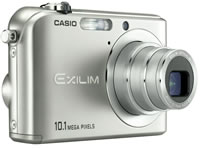 Verdict
Verdict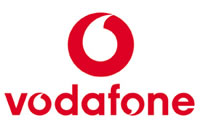 We all know the mobile handset is totally fragmented. Sure there’s a standard – it’s called Nokia – but everyone who isn’t Nokia isn’t very happy about that.
We all know the mobile handset is totally fragmented. Sure there’s a standard – it’s called Nokia – but everyone who isn’t Nokia isn’t very happy about that. Who’s in? Who’s out?
Who’s in? Who’s out? Much excitement is being generated by those companies already using Linux in their handsets. In a ‘don’t forget we’ve been doing this for ages’ way, Yoshiharu Tamura, Executive General Manager, Mobile Terminals Business Unit, NEC Corporation expounded , “As one of the leading pioneers with almost two years of experience shipping Linux-based mobile phones, we are delighted to participate in this initiative. We expect the foundation activities will accelerate further expansion of mobile Linux application developer participation, as well as global market growth of 3G mobile handsets.”
Much excitement is being generated by those companies already using Linux in their handsets. In a ‘don’t forget we’ve been doing this for ages’ way, Yoshiharu Tamura, Executive General Manager, Mobile Terminals Business Unit, NEC Corporation expounded , “As one of the leading pioneers with almost two years of experience shipping Linux-based mobile phones, we are delighted to participate in this initiative. We expect the foundation activities will accelerate further expansion of mobile Linux application developer participation, as well as global market growth of 3G mobile handsets.”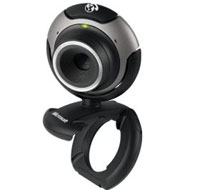 Microsoft has slipped out a pair of branded Webcams designed to offer tight integration with their hideously popular Messenger service.
Microsoft has slipped out a pair of branded Webcams designed to offer tight integration with their hideously popular Messenger service.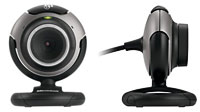 Both cams also come with built in mics, a wide angle lens to let social butterflies fit their vast armies of chums in frame and built-in cheesy video effects like falling snowflakes or twinkling stars.
Both cams also come with built in mics, a wide angle lens to let social butterflies fit their vast armies of chums in frame and built-in cheesy video effects like falling snowflakes or twinkling stars. Here’s Microsoft’s Consumer Productivity Experiences Executive Vice President (who dreams up these job titles?) Tom Gibbons to explain how LifeCams are part of a new initiative by his company to tie in hardware products to Windows Live services.
Here’s Microsoft’s Consumer Productivity Experiences Executive Vice President (who dreams up these job titles?) Tom Gibbons to explain how LifeCams are part of a new initiative by his company to tie in hardware products to Windows Live services.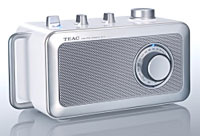 If you find that the modern world is just to fast, too brash, too complicated and just too goddamn digital, you may find TEAC’s new R1 AM/FM Radio the antidote to all those bleeping bits and bytes.
If you find that the modern world is just to fast, too brash, too complicated and just too goddamn digital, you may find TEAC’s new R1 AM/FM Radio the antidote to all those bleeping bits and bytes.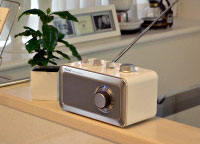 Although -disappointingly – there’s no DAB radio to be found onboard, TEAC has included a line-in socket so that users can play back tunes from new fangled iPods or other players.
Although -disappointingly – there’s no DAB radio to be found onboard, TEAC has included a line-in socket so that users can play back tunes from new fangled iPods or other players.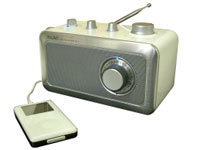 Specifications
Specifications  The second billionth GSM mobile phone is expected to be connected this weekend according to the GSM Association (GSMA).
The second billionth GSM mobile phone is expected to be connected this weekend according to the GSM Association (GSMA).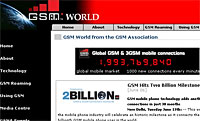 “While it took just 12 years for the industry to reach the first billion connections. The second billion has been achieved in just two and a half years boosted by the phenomenal take up of mobile in emerging markets such as China, India, Africa and Latin America, which accounted for 82% of the second billion subscribers,” he added, breathlessly.
“While it took just 12 years for the industry to reach the first billion connections. The second billion has been achieved in just two and a half years boosted by the phenomenal take up of mobile in emerging markets such as China, India, Africa and Latin America, which accounted for 82% of the second billion subscribers,” he added, breathlessly. The GSM Association continues to develop initiatives to help folks in the developing world gain access to mobile communications, developing a sub$30 low cost mobile phone and putting pressure on governments to remove tax barriers on mobile products and services.
The GSM Association continues to develop initiatives to help folks in the developing world gain access to mobile communications, developing a sub$30 low cost mobile phone and putting pressure on governments to remove tax barriers on mobile products and services. If you’re after super-fast Wireless kit and don’t mind the possibility of buying/refreshing your kit this could well be for you, if not we thought it would be best to start this article with a warning. Although the new PreN RangeMAX NEXT kit looks nice, there is a caveat (ours).
If you’re after super-fast Wireless kit and don’t mind the possibility of buying/refreshing your kit this could well be for you, if not we thought it would be best to start this article with a warning. Although the new PreN RangeMAX NEXT kit looks nice, there is a caveat (ours). RangeMax Next Wireless ADSL Modem Router – DG834N
RangeMax Next Wireless ADSL Modem Router – DG834N RangeMax Next Wireless Routers – Gigabit Edition – WNR854T
RangeMax Next Wireless Routers – Gigabit Edition – WNR854T LG has announced their new multimedia-tastic 12-inch notebook PC, the LW25 EXPRESS DUAL, which is, apparently, “a portable multimedia powerhouse.”
LG has announced their new multimedia-tastic 12-inch notebook PC, the LW25 EXPRESS DUAL, which is, apparently, “a portable multimedia powerhouse.” The built in optical drive (or Super Multi ODD as LG likes to call it) supports playback and recording of all existing optical media formats inluding dual-layer DVD burning, allowing you to cram up to 8.5GB data on a single DVD.
The built in optical drive (or Super Multi ODD as LG likes to call it) supports playback and recording of all existing optical media formats inluding dual-layer DVD burning, allowing you to cram up to 8.5GB data on a single DVD.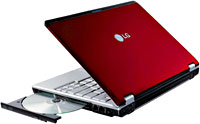 As for pricing and availability, your guess is as good as ours at the moment as LG seem to be keeping mum.
As for pricing and availability, your guess is as good as ours at the moment as LG seem to be keeping mum.